Anthropology News Archive | 2017
-
News | 2017
-
Dr. Carolyn Boyd Awarded the Curtis D. Tunnell Lifetime Achievement Award in Archeology
The Texas Historical Commission selected Dr. Carolyn Boyd as this year’s recipient of the Curtis D. Tunnell Lifetime Achievement Award in Archeology. Named in honor of former State Archeologist and Texas Historical Commission Executive Director Curtis Tunnell, this award recognizes an individual for outstanding lifetime accomplishments in archeological research and/or preservation.
Also, Shumla made the cover of American Archaeology magazine!
-
Congratulations To Our Outstanding Students
Congratulations to JP (mentor Hamilton) for winning the Outstanding Master’s Thesis Award in the Life Sciences!
Kyleigh Hoelscher, an undergraduate honor's student in the department of Anthropology (mentor Taylor), has been awarded an Undergraduate Research Fellowship from Texas State University to support her honor's thesis research on how people experience food insecurity during the holidays.
MA graduate, Caryn Tegtmeyer (mentor Hamilton), is now Dr. Tegtmeyer! Caryn recently passed her dissertation defense at the University of Nevada, Las Vegas.
-
Anthropology Student Awarded Undergraduate Research Fellowship
Kyleigh Hoelscher, an undergraduate student in the department of Anthropology, has been awarded an Undergraduate Research Fellowship from Texas State University to support her honor's thesis research on how people experience food insecurity during the holidays.
-
Dr. Kate Spradley to Give Invited Lecture at Rice University
Dr. Spradley will discuss the humanitarian and human rights crisis pertaining to the migrants that die in South Texas. This lecture will take place October 26, 2017 in Sewall Hall on the Rice University Campus.
-
Dr. Kate Spradley Awarded a Grant From The Homeland Security Grants Division
Dr. Kate Spradley has been awarded a $100,000 grant from the Homeland Security Grants Division (HSGD) through the Office of the Governor to continue her work with Operation ID.
-
Dr. Jill Pruetz Invited to Film Premiere and Interviewed by Neil deGrasse Tyson
Dr. Jill Pruetz was invited to the premier of the new film “Jane” and she was also interviewed by Neil deGrasse Tyson for a National Geographic StarTalk episode with Jane Goodall. You can find clips from the interview on the National Geographic site.
-
Dr. Carolyn Boyd Reviewed in Archaeology
Dr. Carolyn Boyd's book, The White Shaman Mural was recently reviewed in Archaeology.
-
Index of Texas Archaeology is Bepress case study
Two years ago Zac Selden (Center for Regional Heritage Research-SFAU) and Britt Bousman (Texas State-Anthropology) created the Index of Texas Archaeology to provide access to the Cultural Resource Management literature for the State of Texas. As of today (Oct 4, 2017) 16,475 archaeological reports have been downloaded in 105 countries across the globe. The Index of Texas Archaeology is hosted at SFAU and uses Bepress (Berkeley Electronic Press) as the publishing platform. Bepress is now using the Index of Texas Archaeology as a "case study" on its web site.
-
Dr. Carolyn Boyd Selected as one of Leading Women Scientists
Dr. Carolyn Boyd was selected as one of 33 leading women scientists by the Dallas Women's Foundation. The Foundation is featuring women in STEM to elevate the stories of women scientists, and to keep the conversation and interest in advancing women in science, engineering, technology, art and math in the future.
-
Dr. Kate Spradley Presents Research in Italy
Dr. Kate Spradley presents her research on searching for unidentified remains in South Texas to the Forensic Anthropology Society of Europe in Milan, Italy. Dr. Spradley was an invited speaker for this event.
-
Dr. Nicole Taylor Interviewed by "Inside Scoop Live"
Dr. Taylor was recently interviewed about her book Schooled on Fat.
-
Dr. Jill Pruetz Awarded National Geographic Society Grant
Congratulations to Dr. Jill Pruetz has won a National Geographic Society grant of $21,198.00 in support of her proposed project "Thermo-imaging bipedalism on the savanna: Chimpanzee locomotion at Fongoli, Senegal and implications for the evolution of hominin bipedalism."
-
Dr. Todd Ahlman Receives First Task Orders From RFP
Last year Dr. Todd Ahlman was approved for an request for proposal (RFP) with the United States Army Corps of Engineers (USACE). Because of Dr. Alhman’s efforts we are one of three universities that can bid on $45 million dollars of natural and cultural resource projects over the next five years.
Dr. Ahlman has won his first task order award from the USACE for support at multiple Midwest Region Air Force facilities. This task order is for $722,712. The work includes updating Integrated Cultural Resources Management Plans at Mountain Home Air Force Base (AFB) and the US Air Force Academy (we teamed with Versar for this project), an architectural survey of Peterson AFB (we teamed with Mead and Hunt on this project), and hiring five people to work in installations in Colorado (Buckley AFB and Cheyenne Mountain Air Force Station [the former NORAD headquarters]), Utah (Hill AFB), Montana (Malmstrom AFB), and Illinois (Scott AFB).
In addition to this task order, Dr. Ahlman also just received another task order for $938,101 that includes archaeological surveys at the Utah Testing and Training Range (teamed with Cannon Heritage Services where we split crew), Buckley AFB (all Texas State crew), and US Air Force Academy (teamed with Metcalf Archaeology where we split crew) and architectural surveys at Air Force bases in Colorado, Utah, Alaska, South Dakota and North Dakota. We have teamed with Metcalf Archaeology, Historical Research Associates, and Deb McClane for the architectural surveys.
-
Dr. Nicole Taylor awarded NSF Grant
Congratulations to Dr. Taylor who was awarded a nearly $30,000 EAGER (Early-concept Grants for Exploratory Research) grant from the National Science Foundation for her project "Ethical and Methodological Challenges in Social Media Research."
-
Dr. Kent Reilly by local NPR station
Dr. Reilly was recently interviewed by Santa Fe's KSFR station regarding his talk for the "Crossing Global Frontiers" lecture series. His lecture, titled "The Spiro Archaeological Site: Travels on the Path of Souls," focused on Caddoan findings near Spiro, Oklahoma.
-
FACTS faculty member and student participate in ToScA conference
Tomography for Scientific Advancement (ToScA) held its first North American conference at the University of Texas in Austin this month. Devora Gleiber presented a paper entitled "The use of industrial CT in forensic anthropology" (Cunningham, Wescott, Gleiber, Christensen, & Smith), and also presented a poster on her master's thesis research entitled "The effect of mobility impairment on femoral trabecular and cortical bone structure" (Gleiber & Wescott). Additionally, Devora Gleiber and Dr. Deborah Cunningham presented a poster entitled "Variation in the trabecular structure of the proximal tibia between obese and non-obese individuals" (Gleiber, Cunningham, Skipper, & Wescott). The conference was incredibly interesting and informative, and Devora and Deborah enjoyed exploring new collaborative opportunities with colleagues.
-
Anthropology Student Accepted into UT Dallas Graduate Program
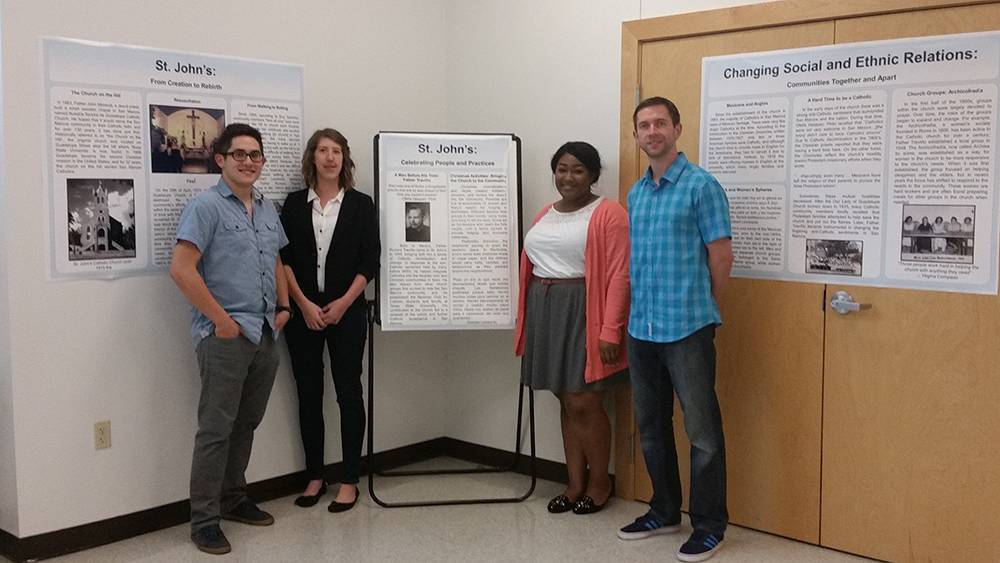 In August 2017, Nicole Tremain (B.A. 2015) will leave her current job as a coordinator and assistant educator at the Perot Museum of Nature and Science to begin the graduate program in Geospatial Information Sciences at the University of Texas at Dallas, where she will combine her interests in anthropology and GIS. Congratulations Nicole!
In August 2017, Nicole Tremain (B.A. 2015) will leave her current job as a coordinator and assistant educator at the Perot Museum of Nature and Science to begin the graduate program in Geospatial Information Sciences at the University of Texas at Dallas, where she will combine her interests in anthropology and GIS. Congratulations Nicole!Ms. Tremain, second from left, exhibits the results of a student research project on St. John’s Catholic Church along with several other students.
-
A path to America Marked by More and More Bodies
The Forensic Anthropology Center and Operation Identification made the front page of the NY Times!
"Over 16 years, the Border Patrol documented 6,023 deaths in the four states bordering Mexico, more than the Sept. 11 attacks and Hurricane Katrina combined.”
“When we get them, we assign them a case number because we have to have a way of tracking cases, but no one deserves to be just a number,” said Timothy P. Gocha, a forensic anthropologist with Operation Identification, a project at Texas State University’s Forensic Anthropology Center that analyzes the remains and personal items of the immigrants to help identify them. “The idea is to figure out who they are, and give them their name back.”
-
Outstanding Graduate Major
Nandar Yukyi is the 2017 Outstanding Graduate Anthropology Major.
Nandar specializes in the study of the human skeleton in the Anthropology master's program. Her thesis focuses on similarities in Asian and Hispanic crania and how these similarities impact ancestry identification in forensic anthropology (mentor, Dr. Spradley). Before graduation this summer, Nandar will spend some time excavating and analyzing humans skeletons at the ancient site of Eleon (Greece) with Dr. Herrmann. After graduation, Nandar will begin her new position at the Defense POW/MIA Accounting Agency.
Congratulations, Nandar, and the best of luck in your career!
-
Outstanding Undergraduate Student for the College of Liberal Arts
Anthropology major Shelly White is the 2017 Outstanding Undergraduate Student for the College of Liberal Arts.
In her essay on the importance of the liberal arts Shelly wrote, "The art and skill of being interdisciplinary is what truly makes the liberal arts great as both academic pursuits and as gateways to careers. My work crosses the borders between math, anthropology, biology, sociology, and medicine, and I am happy to report that each one of these fields seems to think I am rather deviant or possibly insane for entering into all of them with equal enthusiasm. I, instead, happen to think that this is the natural result of a well-rounded liberal arts education at work, doing exactly what it likes to be doing."
Congratulations, Shelly, and the best of luck in graduate school at the University of Washington!
-
2017 Academic Excellence Certificates Award Winners
Award Winners are undergraduate anthropology majors with Texas State GPAs of 3.75 or higher.
Alejandro Allen Avery Armstrong Alexis Baide Nora Berry Isabella Bortolussi Charles Connelly Natalie Dorman Wyatt Ellison Mariana Garcia Duncan Gollihugh Megan Hazelwood Kari Helgeson Ashlee Hickson Shanna High Kyleigh Hoelscher Olivia Hornik Brianna Knight Morgan Parker Victoria Sanchez Chloe Scarborough Margaret Sensiba Anna Shupp Alyssa Wagner Shelly White -
American Association of Physical Anthropologists Conference
Research presented at the 2017 AAPA meeting by Texas State University faculty and students
The Metagenomic Analysis of Oral Microbiome Composition of Dental Calculus Recovered from Institutionalized Individuals from the Mississippi State Asylum, Jackson MS.
Jonathan R. Belanich, Heather R. Jordan, Molly K. Zuckerman, Nicholas P. Herrmann, Shane Miller and Jason RoschEstimating Ancestry in Undocumented Migrants along the South Texas Border using Dental Morphological Traits: A Test of Edgar’s Method.
Chaunesey M.J. Clemmons, M. Kate Spradley and Daniel J. WescottPellagra mortality in the historic Mississippi State Asylum: An investigation and comparison of skeletal data and institutional records.
Michelle L. Davenport, Molly K. Zuckerman, Nicholas P. Herrmann and Michael MurplySeasonal Differences in Accumulated Degree-days on the Rate of Human Decomposition.
Shelby L. Garza and Daniel J. WescottThe Effect of Mobility Impairment on Femoral Trabecular and Cortical Bone Structure.
Devora S. Gleiber and Daniel J. WescottCortical Thickness as a Supplement to Osteon Population Density to Estimate Age at Death.
Timothy P. Gocha, Michelle M. Murach and Amanda M. AgnewSkeletal Stress Markers in Undocumented Border Crossers: A Comparative Approach.
Alexis Goots, Lauren A. Meckel, Devora S. Gleiber and Alejandra Ayala BasExplaining distinct crania from Colonial Delaware using craniometric and genetic analyses.
Kathleen A. Hauther, Ashley H. McKeown, Meradeth Snow and M. K. SpradleyHistorical Bioarchaeology and DVI: Data Integration of the Mississippi State Asylum Burial Sample and Archival Records.
Nicholas P. Herrmann, Michelle L. Davenport, Amber M. Plemons, Grant L. Harley, Audrey D. Shaefer and Molly K. ZuckermanThe confusing case of Grave 42: a bioarchaeological analysis.
Coco James, Kathleen Flor-Stagnato, Erica Cantor, Anna J. Osterholtz, Andre Gonciar and Zsolt NyaradiMethodological Comparison of the Macroscopic vs. Radiographic Assessment of Cranial Porosities within the Texas State University Donated Skeletal Collection.
Brittany S. McClain and Michelle D. HamiltonUnderstanding the Degree of Craniometric Variation in South Texas Migrants.
Chloe P. McDaneld, Timothy P. Gocha, Courtney C. Siegert, Ryan M. Strand, Lori E. Baker and M. Katherine SpradleyThe Utility of Dental Cementum Increment Analysis for Estimating Season-of-Death in Naturally Decomposed Skeletons.
Lauren A. Meckel and Daniel J. WescottHistoric and Skeletal Mortality of the Mississippi State Asylum.
Amber M. Plemons, Michelle L. Davenport and Nicholas P. HerrmannPaleopathological Assessment of Health and Social Status in a Texas Gulf Coastal Plains Population.
Justin A. Pyle, Courtney C. Siegert and Michelle D. HamiltonHorse Trail Shelter (41VV166): Understanding subsistence and lifeways in the Lower Pecos Canyonlands of Texas during the Late Prehistoric using a novel SfM approach to osteological data collection.
Courtney C. Siegert, Charles W. Koenig, Amanda M. Castaneda, Stephen L. Black, Michelle D. Hamilton, Lauren A. Meckel, Devora S. Gleiber and Sophia R. MavroudasObesity affects the accuracy and precision of age at death estimations based on the pelvic joints.
Daniel J. Wescott and Sophia R. Mavroudas -
Dr. Emily Brunson and Dr. Nicole Taylor present at the SfAAs
Drs. Brunson and Taylor attended the Society for Applied Anthropology meetings in Santa Fe, NM where they presented a paper on TAAS.
-
Dr. David Kilby will be the keynote speaker at the 2017 Archaeological Meeting
Dr. David Kilby will be the Adolph Bandelier keynote speaker at the 2017 Annual Meeting of the Archaeological Society of New Mexico. His address, titled “The Role of New Mexico and the Adjacent Southwest in Past and Future Paleoindian Research,” will review both classic Paleoindian sites (Folsom, Blackwater Draw, Bonfire Shelter) and new discoveries, and their roles in our evolving understanding of the Late Pleistocene archaeology of the American Southwest. The meeting is from May 5-7 in Moriarty, NM.
-
Dr. Nicholas Herrmann receives the 2017 CAARI Senior Scholar in Residence Fellowship
 Cyprus American Archaeological Research Institute (CAARI) has awarded Dr. Nicholas Herrmann the 2017 Senior Scholar in Residence Fellowship for in the Ayioi Omoloyites Bioarchaeology Project, which is conducted in Nicosia, Cyprus. Four Texas State University graduate and undergraduate students will be participating on the project this summer. Visit CAARI for more information.
Cyprus American Archaeological Research Institute (CAARI) has awarded Dr. Nicholas Herrmann the 2017 Senior Scholar in Residence Fellowship for in the Ayioi Omoloyites Bioarchaeology Project, which is conducted in Nicosia, Cyprus. Four Texas State University graduate and undergraduate students will be participating on the project this summer. Visit CAARI for more information.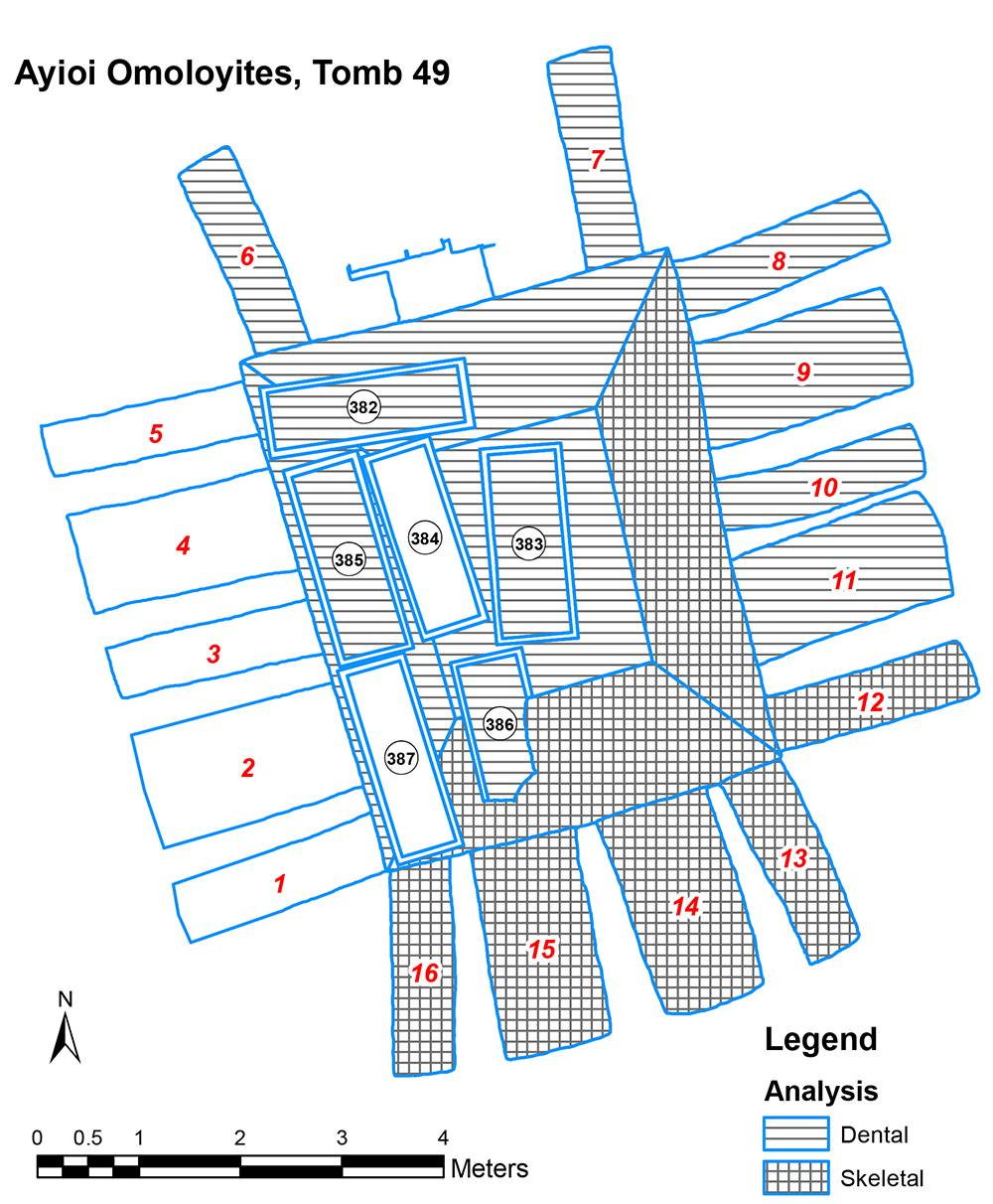

-
Robyn Kramer receives a Graduate Student Travel Grant to SPATIAL
Robyn Kramer (mentor Dr. Nicholas Herrmann) was accepted to the SPATIAL stable isotope short course at the University of Utah with a graduate student travel award of $2,300.

-
Dr. Nicole Taylor's book Schooled on Fat has won two literary awards
Dr. Taylor's book Schooled on Fat has won two literary awards:
Reader Views Literary Award, Societal Issues and the Reviewers Choice Best Non-fiction Book of the Year, Specialty Awards. -
Dr. Kent Reilly to host a School of American Research Symposium in Santa Fe, NM
Dr. Reilly will bring together participants in the Spiro Exhibition to discuss the catalog for the exhibition at The School of American Research in Santa Fe, NM June 2-7, 2017.
-
Dr. Emily Brunson publishes post on MAQ blog
Dr. Emily Brunson publishes post on Medical Anthropology Quarterly blog entitled, "The 'Anecdote' Insult, or Why Health Policy Needs Stories" considers the importance of qualitative/ethnographic research on health policy issues.
-
Dr. Kent Reilly at Board of Regents, University of Alabama Museums, Annual Meeting
On January 27, 2017, Dr. Kent Reilly and the Board of Regents of the University of Alabama Museum Board meet with Lord Cultural Resources and Management to decide on a long therm plan for the expansion of the Moundville Archaeological Park among other cultural facilities run and managed by the University of Alabama.
-
Dr. Kent Reilly takes part in Maya Symposium
On January 13-14, 2017, Dr. Kent Reilly took part in a Maya Symposium, Tlillan Tlapallan the Maya as neighbors in Ancient Mesoamerica. Olmec Iconographic Influences on on the Symbols of Maya Rulership. The identification of elements of the Olmec iconographic system within later Maya art should be predicated on the testable hypothesis that certain elements of the Maya system can be visually identified among Olmec symbols.
-
Lilia Loera (MA 2015) Presents Research on Immigration at Texas A&M University
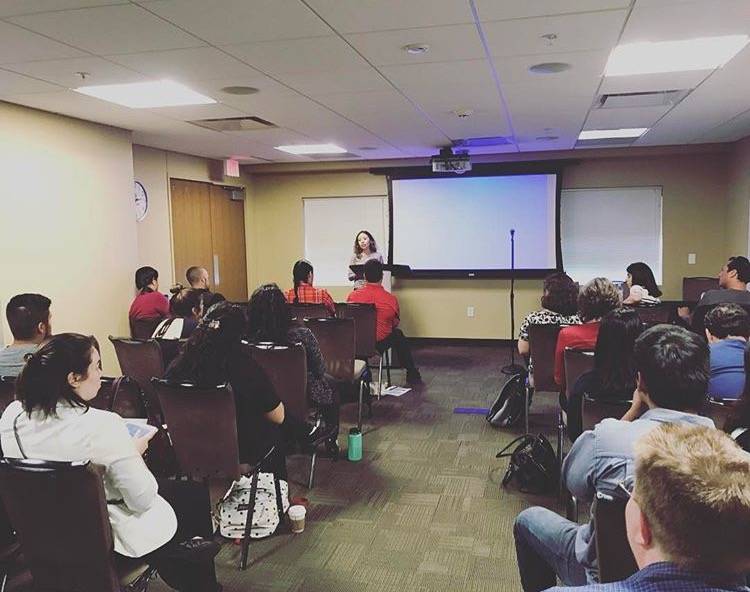 With widespread support, especially from the newly created Minor in Latina/o Mexican American Studies, Texas A&M University hosted the annual Tejas NACCS (National Association for Chicana and Chicano Studies) Conference in February 2017. Drawing on her thesis research with an immigrant rights organization in Houston, Loera demonstrated how social and cultural processes contributed to the success of young immigrant activists. She expects to continue her research on this timely topic in the future.
With widespread support, especially from the newly created Minor in Latina/o Mexican American Studies, Texas A&M University hosted the annual Tejas NACCS (National Association for Chicana and Chicano Studies) Conference in February 2017. Drawing on her thesis research with an immigrant rights organization in Houston, Loera demonstrated how social and cultural processes contributed to the success of young immigrant activists. She expects to continue her research on this timely topic in the future. -
Dr. Kate Spradley elected Anthropology Section Chair for the American Academy of Forensic Sciences
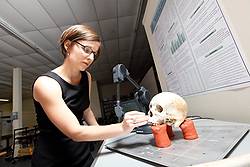 Dr. Spradley was elected in February as the Anthropology Section Chair for the American Academy of Forensic Sciences for 2017 - 2018.
Dr. Spradley was elected in February as the Anthropology Section Chair for the American Academy of Forensic Sciences for 2017 - 2018. -
Dr. Nicole Taylor Presents at Pacific University
Dr. Taylor will give a presentation about her body image research and lead a workshop on career paths for anthropology majors at Pacific University in Forest Grove, Oregon on March 13.
Presentation: Teens, Body Image, and Obesity: Exploring Intersections of Discourse, Practice, and Policy
Dr. Nicole Taylor will share findings from her research on how youth navigate body image concerns within a dominant culture that reinforces widespread beliefs about body size as a matter of personal responsibility while offering limited opportunity to exercise and an abundance of junk foods. Drawing on daily participant observation, interviews, and focus groups over the course of a school year, Taylor’s research explores how youth managed their body size, social status, and identities as body-conscious individuals. Taylor also traces policy efforts and offers practical strategies for promoting teen wellness.Workshop: Making Anthropology Work for You: Career Paths and Next Steps
In this workshop Dr. Nicole Taylor provides information about career pathways for anthropology majors, drawing on her own experience as a practicing anthropologist working in non-profit and corporate settings. We will also explore strategies for finding jobs and marketing oneself as an anthropologist. -
Center for Archaeological Studies provides CRM Training for Texas State Students
Sometimes the perfect survey comes along to help us fulfill our mission to provide student training in the fields of cultural resource management and archaeological research. Today, CAS archaeologist Jacob Hooge has his teacher hat on as he provides some training in archaeological survey methods for a crew of Texas State Anthropology graduate students.

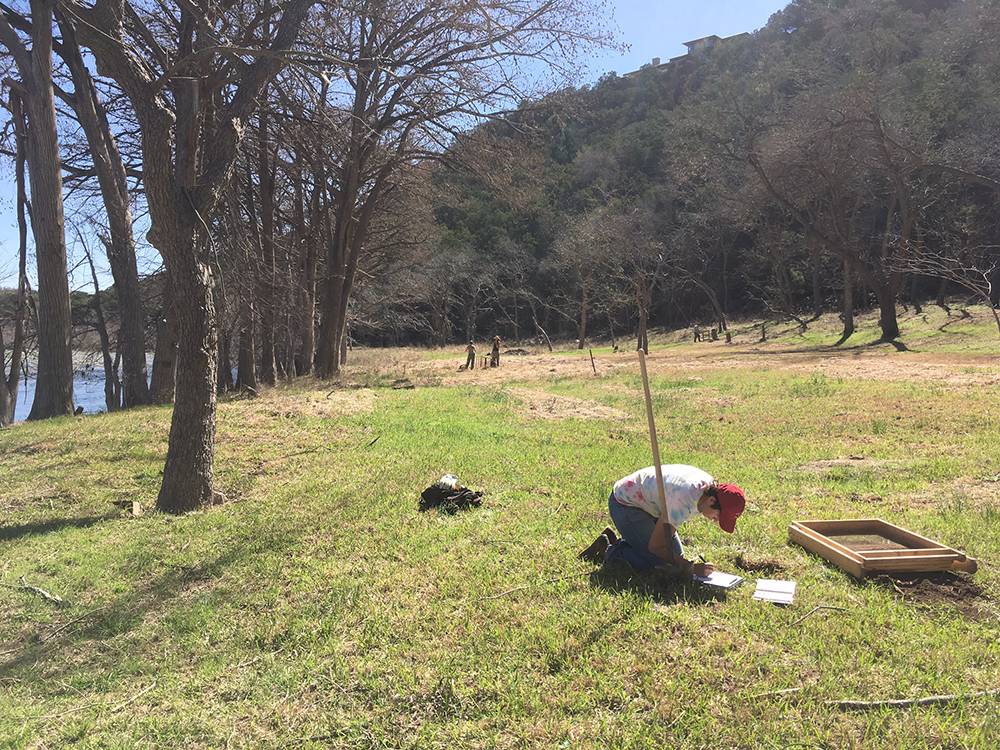
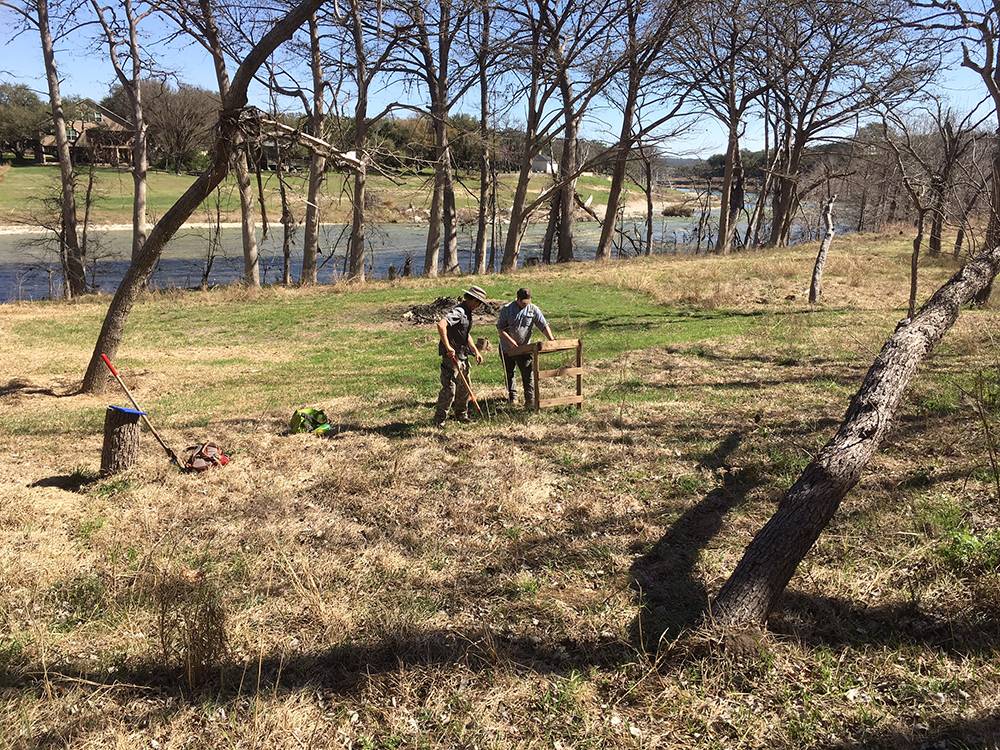
-
Ancient Southwest Texas Project featured on NPR
NPR's Nature Notes covers Texas State archaeological research in the Trans-Pecos region of Texas. Read or listen to the show on Marfa Public Radio.
-
Archaeological Research at Bonfire Shelter featured on NPR
NPR's Nature Notes covers Texas State archaeological investigations at Bonfire Shelter, TX. Read or listen to the show on Marfa Public Radio.
-
Texas State Students at AAFS 2017
Several current and former Texas State Anthropology graduate students presented work at the 2017 American Academy of Forensic Sciences conference in New Orleans, Louisiana.
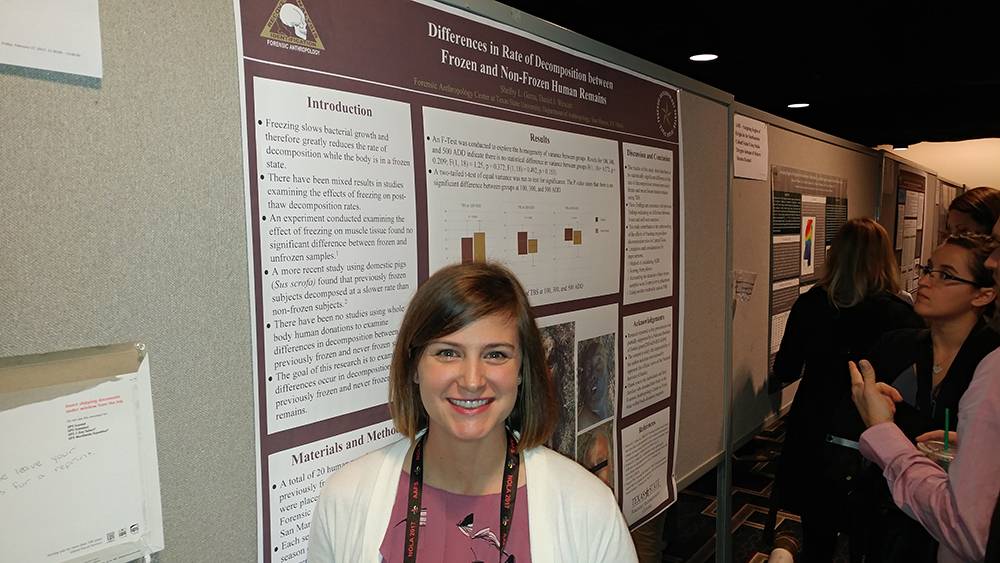
Shelby Garza is an undergraduate majoring in anthropology, and presented the poster entitled 'The Differences in the Rate of Decomposition Between Frozen and Non-Frozen Human Remains" that she co-authored with Dr. Wescott.
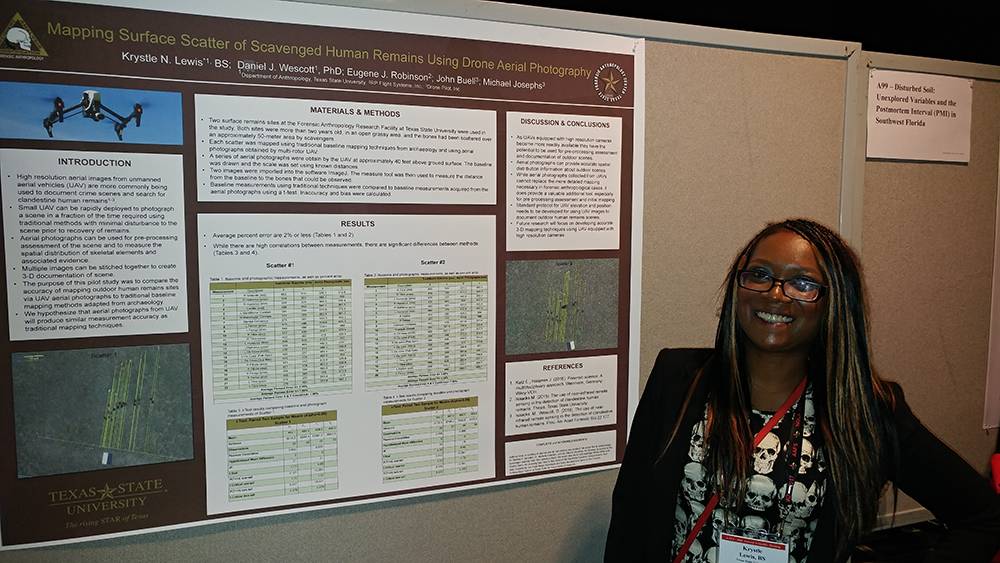
Krystal Lewis presented part of her Master's thesis research in a co-authored poster entitled "Mapping Surface Scatter of Scavenged Human Remains Using Drone Aerial Photography."
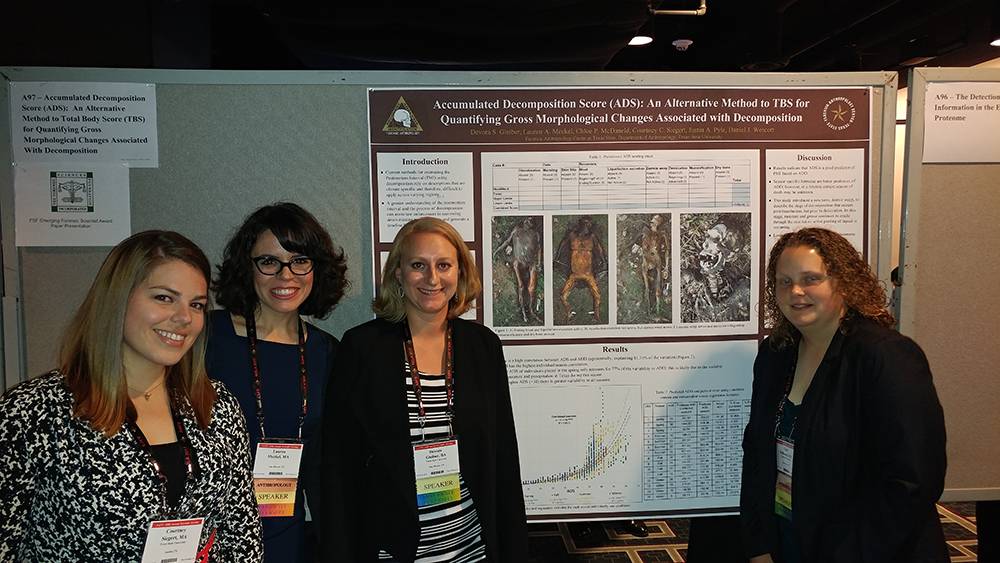
Current and recently graduated Master's students present their collaborative research project: "Accumulated Decomposition Score (ADS): An Alternative Method to Total Body Score (TBS) for Quantifying Gross Morphological Changes Associated With Decomposition." (left to right: Courtney Siegert, Lauren Meckel, Devora Gleiber, and Chloe McDaneld)
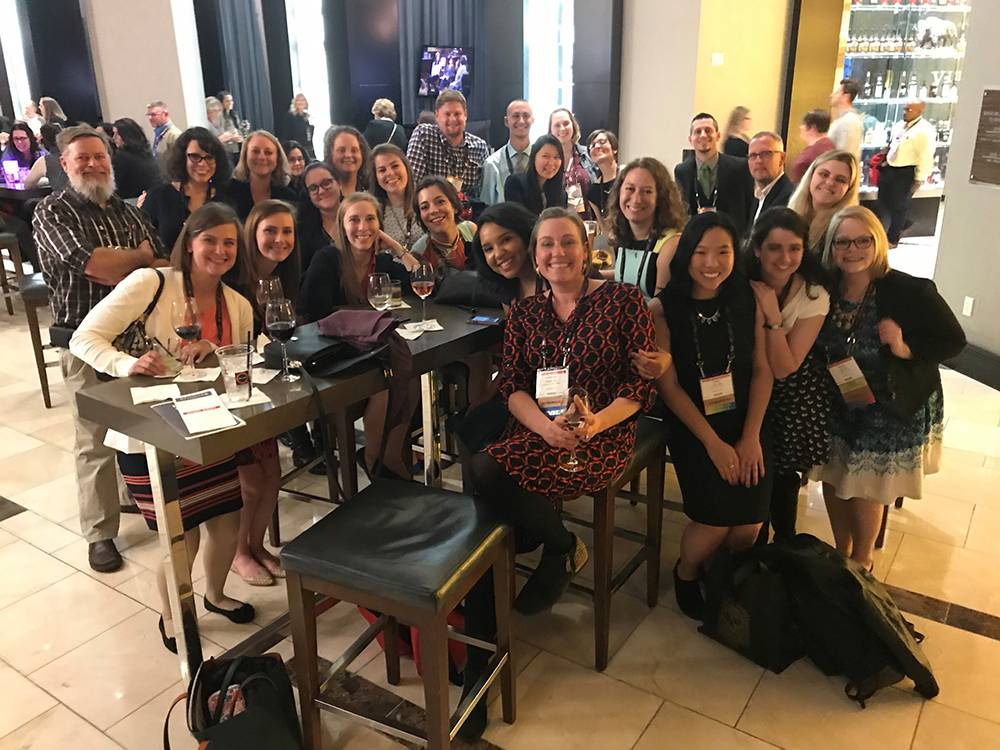
Current and former students, and faculty members.
-
Dr. Carolyn Boyd wins the Society for American Archaeology Book Award
 Dr. Carolyn Boyd has been selected by the Society for American Archaeology as the 2017 recipient of their book award for her new book, The White Shaman Mural: An Enduring Creation Narrative in Rock Art of the Lower Pecos.
Dr. Carolyn Boyd has been selected by the Society for American Archaeology as the 2017 recipient of their book award for her new book, The White Shaman Mural: An Enduring Creation Narrative in Rock Art of the Lower Pecos. This short video that highlights the work Dr. Boyd and her team (including our students) are doing in the Lower Pecos.
-
FACTS faculty and student presentations at the AAFS in NOLA February 13-18
Bytheway, Joan A., Nicole Miller, Dawnie Steadman, Kelly Sauerweins, Dr. Daniel J. Wescott, Chaunesey M.I. Clemmons, Devora S. Gleiber, Chloe P. McDaneld, and Lauren A. Meckel. Validation of TBS/ADD equation at 100, 300, 500, and 1000 ADD on 30 human subjects with known PMI from three human decomposition facilities Proceedings of the American Academy of Forensic Sciences 23:248, American Academy of Forensic Sciences, New Orleans, LA.
Christensen, Angi M., Michael A. Smith, Deborah L. Cunningham, Daniel J. Wescott, and Devora S. Gleiber. The use of industrial CT in forensic anthropology. Proceedings of the American Academy of Forensic Sciences 23:216, American Academy of Forensic Sciences, New Orleans, LA.
Clemmons, Chaunesey, Nandar Yukyi, Kate Spradley. The accuracy of estimating ancestry in undocumented migrants along the south Texas border using dental morphological traits: a comparison to craniometrics. Proceedings of the American Academy of Forensic Sciences 23:198, American Academy of Forensic Sciences, New Orleans, LA.
Garza, Shelby and Daniel J. Wescott. Differences in rate of decomposition between frozen and non-frozen human remains. Proceedings of the American Academy of Forensic Sciences 23:214, American Academy of Forensic Sciences, New Orleans, LA.
Gleiber, Devora S., Lauren A. Meckel, Courtney C. Siegert, Chloe P. McDaneld, Justin A. Pyle, and Daniel J. Wescott. Accumulated decomposition score (ADS): an alternative method to TBS for quantifying gross morphological changes associated with decomposition. Proceedings of the American Academy of Forensic Sciences 23:206, American Academy of Forensic Sciences, New Orleans, LA.
Gocha, Timothy P., Kate Spradley, Ryan Strand, Bruce E. Anderson, Alicia Lusiardo. The role of the anthropologist in the identification and repatriation of deceased migrants along the United States-Mexico border. Proceedings of the American Academy of Forensic Sciences 23:272, American Academy of Forensic Sciences, New Orleans, LA.
Gordon, Gwyneth, Tiffany Saul, Dawnie Steadman, Kelly Knudson, Daniel J. Wescott. Preservation of hair stable isotope signature during freezing. Proceedings of the American Academy of Forensic Sciences 23:700, American Academy of Forensic Sciences, New Orleans, LA.
Ingvoldstad, Megan E., Timothy P. Gocha, Christian Crowder, Victoria M. Dominguez. Examining the effect of region of interest (ROI) size on the ability to accurately estimate age at death from osteon population density (OPD). Proceedings of the American Academy of Forensic Sciences 23:177, American Academy of Forensic Sciences, New Orleans, LA.
Kovic, Christine M., Mercedes Doretti, Kate Spradley, Eduardo Canales, Molly Miranker, Rachel Daniell, Ryan Strand, Timothy P. Gocha, Robin C. Reineke, Chelsea Halstead. The Forensic Border Coalition (FBC): collaboration in forensic sciences, human rights, and public policy. Proceedings of the American Academy of Forensic Sciences 23:270, American Academy of Forensic Sciences, New Orleans, LA.
Lewis, Krystle N., Daniel J. Wescott, Eugene J. Robinson, John Buell, and Michael Josephs. Mapping surface scatter of scavenged human remains using drone aerial photography. Proceedings of the American Academy of Forensic Sciences 23:211, American Academy of Forensic Sciences, New Orleans, LA.
Spradley, Kate, Mercedes Doretti, Christine M. Kovic, Molly Miranker, Rachel Daniell, Timothy P. Gocha, Ryan Strand, Alberto Giordano. Searching for the unidentified in South Texas: the Forensic Border Coalition (FBC) cemetery survey project. Proceedings of the American Academy of Forensic Sciences 23:268, American Academy of Forensic Sciences, New Orleans, LA.
Warner, Monica M., Amber M. Plemons, Nicolas P. Herrmann, Laura A. Regan. Proceedings of the American Academy of Forensic Sciences 23:212, American Academy of Forensic Sciences, New Orleans, LA.
-
Graduate student, Jessica Galea, wins American Association of Physical Anthropology (AAPA) Pollitzer Essay award
Graduate student, Jessica Galea (mentor Dr. Daniel Wescott), won an American Association of Physical Anthropology (AAPA) Pollitzer Essay award. There were 118 entries and 50 awards. The award is a $500 travel stipend to attend this year’s AAPA conference. Further, because Jessica’s essay was ranked in the top 10 essays, she’s been invited to participate in the AAPA Presidential panel on, “What’s in a Name.” Jessica’s essay is attached.
Jessica Galea | AAPA William S. Pollitzer Student Travel Award 2017
Labels are meaningful ways of courting group solidarity as well as drawing lines between groups. Today’s American Association of Physical Anthropologists bears little resemblance to that of its founders. As the phrase “biological anthropology” becomes increasingly common among journal articles and academic programs, it is clear that while we share a common ancestor, it is time to recognize a new species: the American Association of Biological Anthropologists.
The physical anthropology of the 19th and early 20th centuries, much like that of the 21st century, aimed to explore human biological variation. Technology has made enormous leaps, though methodologies remain remarkably similar. The difference, then, lies in how we apply what we’ve learned – and the lens through which we interpret our data. The first physical anthropologists used physical variation between “races” as evidence for biological and mental hierarchies, which is our greatest sin. Boas, however, was quick to point out the importance of environment and genetics, and thus the fluidity of populations (Boas, 1899). At mid-century, Washburn’s “New Physical Anthropology” called for a paradigm shift that emphasized problem-oriented research through a population genetics lens, rather than mere physical description (Washburn, 1951). This shift strengthened physical anthropology’s resemblance to the biological sciences; by then, both fields had embraced evolutionary theory as their conceptual backdrops. Thus, a change to "biological anthropology" makes the most sense. It neatly encapsulates the vast array of questions we address.
Indeed, physical anthropology continues to evolve in all but the professional organization and journal’s names: the term “biological anthropology” is widely used in journal articles and is the preference of the National Science Foundation and a majority of graduate programs listed on the AAPA website. Use of the term in the AJPA goes back as far as 1983 (Rourke and Petersen, 1983). Practicing anthropologists have long been ready for change. As our science becomes ever more involved in public outreach, it is imperative that our professional organization represent us as we see ourselves. A new personal label brings with it a new frame of mind: “Being called Biological Anthropologists, and thinking like a biological anthropologist,” makes relating to the public “easier than being labeled a Physical Anthropologist, which, in the eyes of the public and in those of many science writers, confines us to a limited sphere,” which does not resonate with our modern goals (Fuentes, 2010:5). Changing the names of our professional organization and journal is an important step toward improving public accessibility in a time when outreach is critical, if not welcomed. This may seem a superficial gesture, but when a name is the public’s first introduction, it could easily be the difference between indifference and curiosity.
As anthropologists, we are well aware of the power of language and words. Our linguistic choices are no accident. George Dorsey was aware of this when he declared our subdiscipline the study of “physical man” (Dorsey, 1897:109). “It treats of man as an animal,” he continued, after listing the things physical anthropology does not consider – all of which are what make us human. “Physical” calls to mind stagnation and rigidity, which is very much in line with contemporary views such as biological determinism. Furthermore, these early practitioners were physicians first. Today’s anthropologists advocate a holistic approach that treats humans as complex beings whose biology cannot be separated from their sociocultural context. Perhaps the change would be merely a symbolic break from the past; it certainly could not erase it (nor should it). Rather, it would function as a statement that the subfield has gone through growing pains and has emerged as a new and fascinating creature that works to improve lives. Calling ourselves biological anthropologists returns emphasis to what makes this science possible: the living (or once living) subjects who have taught us so much about ourselves. It is time for the American Association of Biological Anthropologists to be born.
Boas F. 1899. Some Recent Criticisms of Physical Anthropology. American Anthropologist 1:98-106.
Dorsey GA. 1897. Physical Anthropology. Science. 6:109-120.
Fuentes A. 2010. The new biological anthropology: Bringing Washburn's new physical anthropology into 2010 and beyond - The 2008 AAPA lecture. American Journal of Physical Anthropology 143:2-12.
Rourke DHO, Petersen GM. 1983. Biological Anthropology and Genetic Disease Research: Introduction. American Journal of Physical Anthropology 62:1-2.
Washburn SH. 1951. The New Physical Anthropology. Transactions of the New York Academy of Sciences 2:298-304.
-
Wescott speaks at National Sojourners meeting in Austin
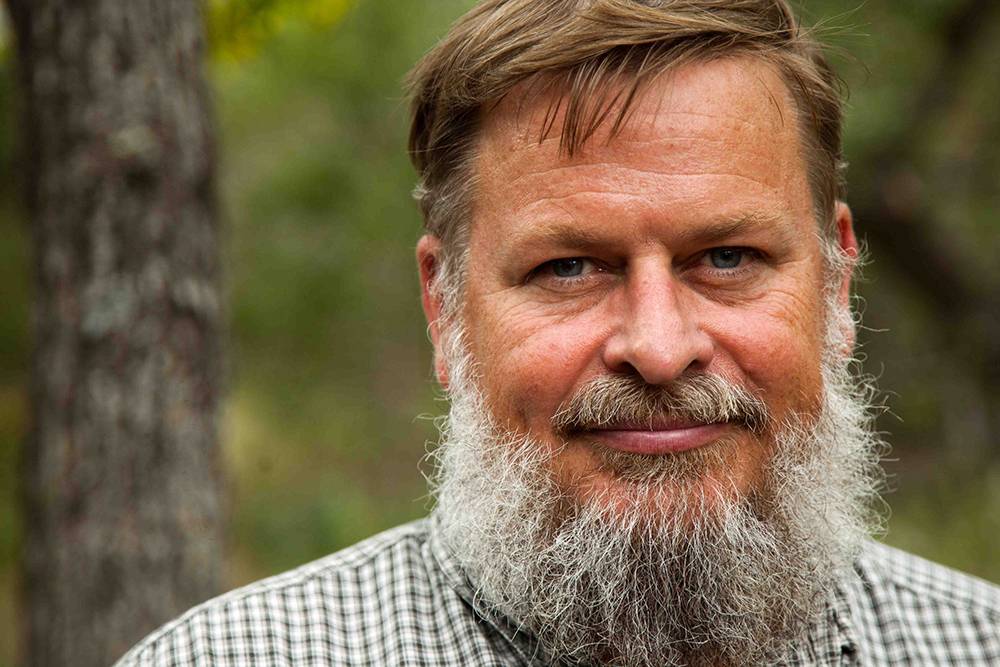 Dr. Wescott will give a presentation about the Forensic Anthropology Center at Texas State to the National Sojourners meeting on February 22.
Dr. Wescott will give a presentation about the Forensic Anthropology Center at Texas State to the National Sojourners meeting on February 22. -
Congratulations to all of the FACTS faculty, staff and students!
NYT Arts coverage of the Forensic Anthropology Center. Dr. Wescott and the rest of the staff worked with Shults for more than a year on this.
-
Volunteer work by Texas State and Indianapolis University Faculty
Below is a link to an article on the volunteer work done by Texas State and Indianapolis University faculty and students over the holiday break. The team recovered the remains of migrants who were buried in unmarked graves in the Sacred Heart Cemetery in Falfurrias, Texas. Dr. Kate Spradley, Dr. Nick Herrmann and Dr. Tim Gocha led the exhumations and mentored the students. The work went very smoothly and was the first step in identifying and returning these individuals to their families. Congratulations to all!
-
Texas Project Works To Name Migrants Lost Crossing The Border
KXAN published a story on migrant identification featuring work from Dr. Kate Spradley.
-
